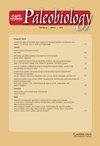时间深处的青蛙四肢:跳跃运动是人类的根源吗?
IF 2.7
2区 地球科学
Q2 BIODIVERSITY CONSERVATION
引用次数: 0
摘要
蛙类(Lissamphibia: Anura)独特的身体计划至少从200万年前就被保存下来了,但其从更广泛的四足动物状态进化而来的过程仍然知之甚少,部分原因是由于缺乏早期化石记录的Salientia,即无尾猿总群。anuran Bauplan的起源被经典地解释为对跳跃的适应,但最近的研究结合了系统发育背景下的新数据,挑战了流行的跳跃假说。在这里,我们从古生物学的角度重新审视并验证了这一假设,通过整合来自广泛的现存和化石青蛙的肢体数据。我们首先探讨了从侏罗纪到古近纪的肢体比例的演变,以了解目前的肢体多样性起源于何时,以及在过去200万年中肢体比例是否以及在多大程度上被保存下来。然后,我们通过系统发育灵活判别分析推断已灭绝物种的运动能力,并根据这些推断,我们研究了蛙类在地质时期的运动多样性,并重建了蛙类显着种的祖先状态。肢体比例的进化以侏罗纪早期的多样化为特征,随后在早白垩纪已经探索过的有限区域的形态空间中反复趋同。与这种早期肢体多样性一致的是,侏罗纪茎类也具有运动多样性,它们推断的运动模式不支持跳跃假说。我们提出,在此发现的肢体比例和运动能力在地质时期的重复趋同进化模式阻碍了任何自信地推断祖先运动模式的尝试,因此,可能是时候开始关注与运动无关的其他关于anuran Bauplan起源的假设了。本文章由计算机程序翻译,如有差异,请以英文原文为准。
Frog limbs in deep time: is jumping locomotion at the roots of the anuran Bauplan?
Abstract The unique body plan of frogs (Lissamphibia: Anura) has been largely conserved from at least 200 Myr, and its evolution from a more generalized tetrapod condition is still poorly understood, in part due to the scarce early fossil record of Salientia, the anuran total-group. The origin of the anuran Bauplan has been classically explained as an adaptation to jumping, but recent studies incorporating new data in a phylogenetic context have challenged the popular jumping hypothesis. Here we revisit and test this hypothesis from a paleobiological perspective by integrating limb data from a wide range of extant and fossil frogs. We first explored the evolution of limb proportions from the Jurassic to the Paleogene to understand when the present limb diversity originated and whether, and to what extent, limb proportions have been conserved over the last 200 Myr. We then inferred the locomotor capabilities of extinct species by phylogenetic flexible discriminant analysis, and from these inferences, we studied the locomotor diversity of frogs over geological time and reconstructed the ancestral state for frog-like salientians. The evolution of limb proportions is characterized by an early diversification that was underway in the Jurassic, followed by a repeated convergence over a limited area of the morphospace that was already explored by the Early Cretaceous. In agreement with this early limb diversity, the Jurassic stem species were also locomotory diverse, and their inferred locomotor modes do not support the jumping hypothesis. We propose that the patterns found herein of repeated convergent evolution of both limb proportions and locomotor capabilities over geological time hamper any attempt to confidently infer the ancestral locomotion mode and, it therefore might be time to start focusing on other hypotheses on the origin of the anuran Bauplan that are not related to locomotion.
求助全文
通过发布文献求助,成功后即可免费获取论文全文。
去求助
来源期刊

Paleobiology
地学-古生物学
CiteScore
5.30
自引率
3.70%
发文量
38
审稿时长
>12 weeks
期刊介绍:
Paleobiology publishes original contributions of any length (but normally 10-50 manuscript pages) dealing with any aspect of biological paleontology. Emphasis is placed on biological or paleobiological processes and patterns, including macroevolution, extinction, diversification, speciation, functional morphology, bio-geography, phylogeny, paleoecology, molecular paleontology, taphonomy, natural selection and patterns of variation, abundance, and distribution in space and time, among others. Taxonomic papers are welcome if they have significant and broad applications. Papers concerning research on recent organisms and systems are appropriate if they are of particular interest to paleontologists. Papers should typically interest readers from more than one specialty. Proposals for symposium volumes should be discussed in advance with the editors.
 求助内容:
求助内容: 应助结果提醒方式:
应助结果提醒方式:


